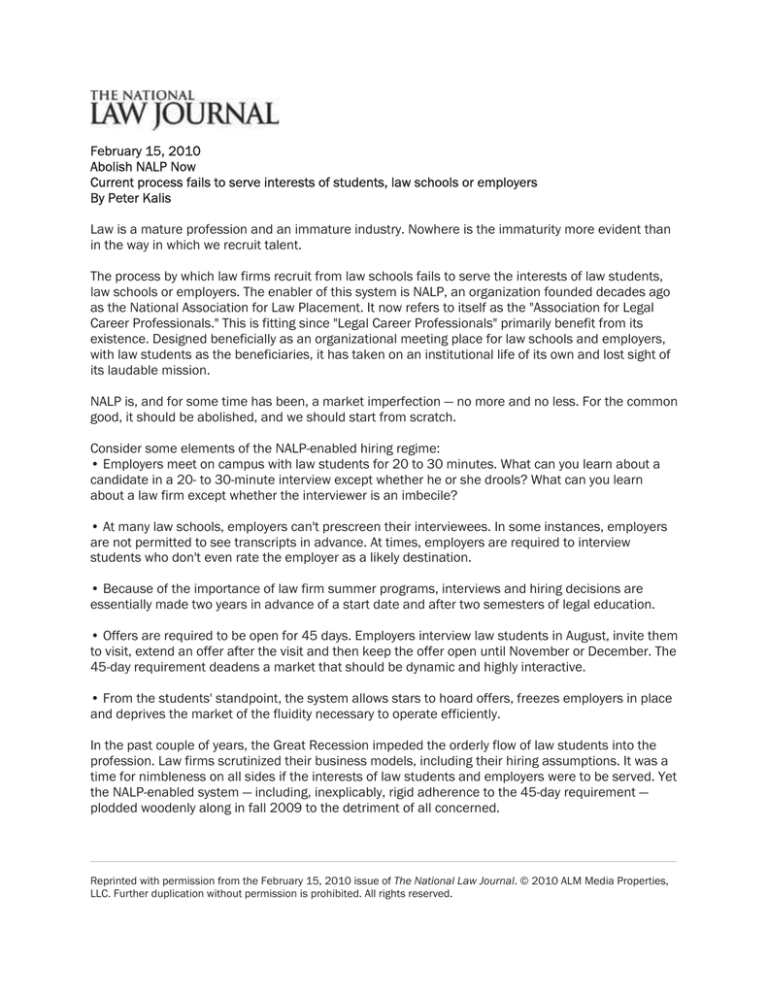
February 15, 2010
Abolish NALP Now
Current process fails to serve interests of students, law schools or employers
By Peter Kalis
Law is a mature profession and an immature industry. Nowhere is the immaturity more evident than
in the way in which we recruit talent.
The process by which law firms recruit from law schools fails to serve the interests of law students,
law schools or employers. The enabler of this system is NALP, an organization founded decades ago
as the National Association for Law Placement. It now refers to itself as the "Association for Legal
Career Professionals." This is fitting since "Legal Career Professionals" primarily benefit from its
existence. Designed beneficially as an organizational meeting place for law schools and employers,
with law students as the beneficiaries, it has taken on an institutional life of its own and lost sight of
its laudable mission.
NALP is, and for some time has been, a market imperfection — no more and no less. For the common
good, it should be abolished, and we should start from scratch.
Consider some elements of the NALP-enabled hiring regime:
• Employers meet on campus with law students for 20 to 30 minutes. What can you learn about a
candidate in a 20- to 30-minute interview except whether he or she drools? What can you learn
about a law firm except whether the interviewer is an imbecile?
• At many law schools, employers can't prescreen their interviewees. In some instances, employers
are not permitted to see transcripts in advance. At times, employers are required to interview
students who don't even rate the employer as a likely destination.
• Because of the importance of law firm summer programs, interviews and hiring decisions are
essentially made two years in advance of a start date and after two semesters of legal education.
• Offers are required to be open for 45 days. Employers interview law students in August, invite them
to visit, extend an offer after the visit and then keep the offer open until November or December. The
45-day requirement deadens a market that should be dynamic and highly interactive.
• From the students' standpoint, the system allows stars to hoard offers, freezes employers in place
and deprives the market of the fluidity necessary to operate efficiently.
In the past couple of years, the Great Recession impeded the orderly flow of law students into the
profession. Law firms scrutinized their business models, including their hiring assumptions. It was a
time for nimbleness on all sides if the interests of law students and employers were to be served. Yet
the NALP-enabled system — including, inexplicably, rigid adherence to the 45-day requirement —
plodded woodenly along in fall 2009 to the detriment of all concerned.
______________________________________________________________________
Reprinted with permission from the February 15, 2010 issue of The National Law Journal. © 2010 ALM Media Properties,
LLC. Further duplication without permission is prohibited. All rights reserved.
Now NALP asks that we consider a fundamental reform to this system: No employer would be
permitted to issue an offer of employment before a date certain in January, after which the offer
would remain open for 14 days.
Here are a few observations about this reform proposal, which I earlier passed on to NALP:
• Although no formal offers could issue before the January date, firms could give "winks and nods" to
their top choices starting with interviews the prior August. Law students would have a sense of which
firms will extend offers to them, unless, of course, law firms wink and nod indiscriminately to keep
options open.
• This would create an intensely competitive but sloppy and confusing recruitment atmosphere
resulting in weeks and even months of wining and dining and follow-up visits, a substantial increase
in the cost of recruiting and more disruption to legal education and students' personal lives. To what
end? Competition for jobs and talent should focus on finding where the merits and aspirations of the
student and employer intersect, not on shock-and-awe campaigns. There should be a rational
relationship between energy expended and insights gained on both sides.
• Students would be distracted by the longer time period in which to sort through employment
choices for the following summer. Can it be good for law schools and law students that the entire
first semester through examinations would be spent in the recruitment orgy?
• The most stellar candidates would await and receive offers from multiple firms, and, with no
contrary incentive, those students would be unlikely to withdraw from consideration before the
January date or to release a single offer after the January date.
• Prior to the 14-day acceptance deadline, candidates could accept offers and then withdraw their
acceptances when they have an offer they desire more. This would cause an administrative
nightmare and would hamper firms' efforts to achieve the appropriate class sizes and yield.
• The end-of-the-year realities of law firm management (collections, billings, setting bonuses and
compensation) coupled with the holiday season and law school exams render a January offer date
undesirable.
The proven deficiencies of the existing NALP-enabled regime and the organization's questionable
reform proposal disqualify it from a leadership role in our profession. Surely a representative group
of law students, law school deans and employers could sit down and discuss better solutions than
those offered by the Association for Legal Career Professionals.
More fundamentally, every September, students arrive at law schools and most graduate 33 months
later. For 27 of those months they are students and for six they are employees. Isn't it time for an
integrated approach to this 33-month track that better serves the interests of those students, who,
lest we forget, are our future? Such an integrated approach would transcend recruitment, but a
rationally reformed recruitment process would be a good place to begin.
Peter Kalis is the chairman and global managing partner of K&L Gates.
-2-



